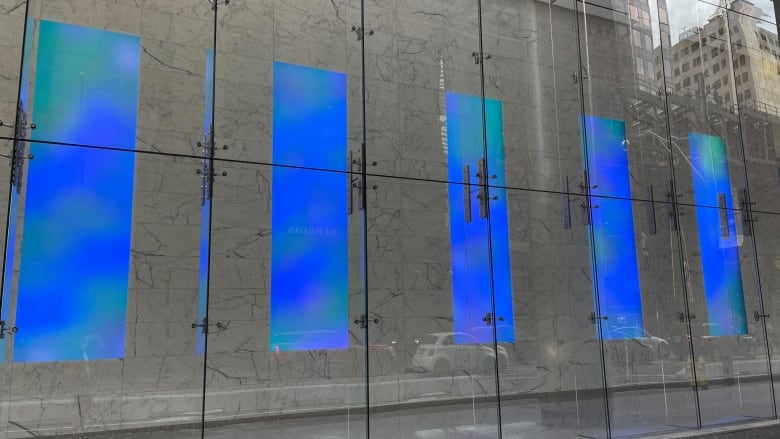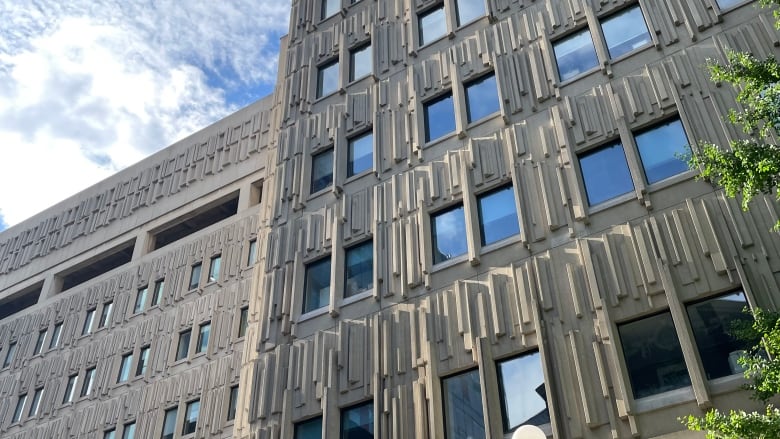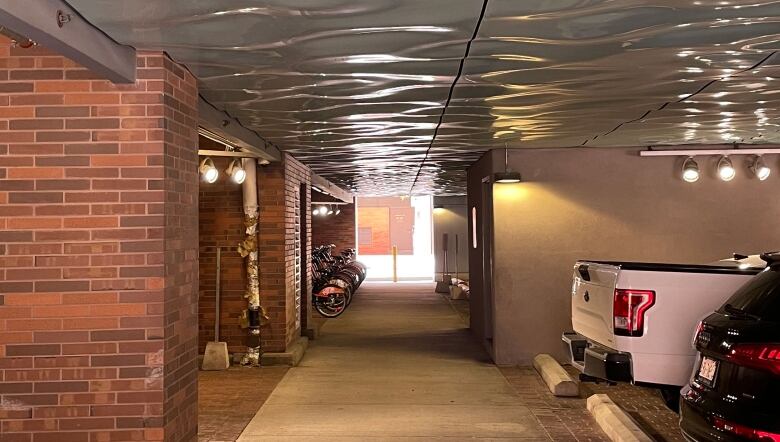Toronto's best-kept secrets: these incredible artworks are free to see
Field trip ideas for your lunch break ... or your next big trip to the city

It's not always visible, it's not always explained and there's not always a plaque. But if you love art, Toronto is a fantastic place to find it. And yet, if you've ever taken a walk downtown, you've probably zipped past something remarkable without even realizing it was there.
Toronto's official inventory of public art and monuments includes more than 400 items and on top of all that, there are countless treasures hiding in plain sight. There are free galleries of corporate-owned masterpieces nestled in the PATH. Murals are everywhere: in the laneways and alleys and stretching up skyscrapers.
So what's worth seeking out? CBC Arts asked a few experts who've made public art a part of their daily lives. According to them, these spots are definitely worth a closer look. So the next time you're rushing to the train or just getting lost downtown take a moment to discover these hidden gems.
Straight Flush
Where is it? Bay Adelaide Centre, 333 Bay St.
The Bay Adelaide Centre commissioned this light installation from American artist James Turrell in 2009, a full seven years before Drake was riffing on the artist's work for the "Hotline Bling" video. It's one of the few Toronto landmarks that you'll find in CBC Arts' special feature, Destination: Art, and while it's fully visible from the street, you've got to wonder whether most people rushing through the Financial District find enough time on their lunch breaks to stop and wonder at it.
The piece, which is found on the south side of the lobby, is comprised of five tall panels that cycle through a sequence of vibrant colours. Its electric palette pulses gently, bathing the white walls of the Bay Adelaide Centre in sunset hues.
"I love that piece so much because people don't expect much from it," says Ryanne Florence-Perry, an artist who works as a Walk T.O. tour guide. Public art, culture and history are the company's specialties, and they offer educational tours for kids in middle and high school. Straight Flush is a must-see on Florence-Perry's route, she says. When she brings students to the corner of Bay and Adelaide, she asks them to imagine the mindset of an office worker. Maybe when they exited the elevator, Straight Flush was pulsing aqua green; and in the time it takes to order a coffee and take it back to their cubicle, the lights might be violet or watermelon-pink.
"The artist wants you to notice the aspect of time passing by," says Florence-Perry. "Time is always passing and every second is different. And we have decisions to make in every moment of our lives. We can choose to appreciate a beautiful thing, or not and just pass it by."
Explore these under-the-radar Canadian art destinations
- Destination: Art isour masterlist ofunique places to experience art in Canada
- A Toronto sculpture park with otherworldly vibes that has been used as a backdrop for music videos from artists likeMartha and the Muffins,Mil-Specand Drake.
- Tinkls' Gallery, in Sunderland Ontario,is a Xanadu unparalleled in the world of Canadian art.
- If you want to see great art in Muskoka, take a hike
- Doris in tinyBeaverlodge Alta. brings boldly experimental art to a rural space
- Howwe turned a trailer full of art into the NWT's only non-commerical contemporary art space.
Two Circles
Where is it? Bay Adelaide Centre, 333 Bay St.

Steps from Straight Flush, this piece by Toronto-based artist Micah Lexier can be found in the Bay Adelaide Centre's East Tower lobby. It's another essential stop, according to Florence-Perry and a moving companion to Turrell's Straight Flush, especially if you're the kind of person who never stops for a lunch break.
From a distance, the work seems simple in form. Two circles loom large, splashed on opposite walls. But they're not what they seem, and when Florence-Perry brings tours through the lobby, she always asks her group to guess what the dots are made of. Invariably, the kids never agree on a single answer, so she invites them to get closer. And when they're nose to the wall, it all becomes clear: the art is made ofceramic sticks 830,000 of them, and each one is cracked to reveal a jagged fissure.

"If you look closely at the break line, it looks like a heartbeat," she says.
"Like the James Turrell, I see that as another acknowledgement of time passing by; every moment our heart is beating to keep us alive."
Allen Lambert Galleria
Where is it? Brookfield Place, 181 Bay St.

Something like Micah Lexier's Two Circles exists because of the City of Toronto's Percent for Public Art Program. For decades, it's required private developers to contribute a fraction of their construction costs to the commissioning of art permanent projects that are available for everyone in the community to experience. Sometimes, the artwork that comes out of the program winds up living in one of the new builds; other times, a developer's contributions get pooled for an off-site project. And one of Jol Len's favourite places in Toronto is a unique example of how the program has spawned landmarks throughout the city. Because if you want to talk about public art that's permanent, there are few better models than this: an entire architectural space that's renowned for its soaring beauty and a spot that's familiar to any tourist who's stopped by the Hockey Hall of Fame.
The Allen Lambert Galleria is the atrium connecting the towers of Brookfield Place. It's a public square, of sorts, covered by a six-story canopy of parabolic white arches. It was designed by Santiago Calatrava, the Spanish architect behind Calgary's Peace Bridge; the Montjuc Communications Tower in Barcelona and the World Trade Center Transportation Hub in New York. "Few people know, but that amazing space was the building's contribution to the Percent for Public Art program," says Len, executive director of the Toronto Society of Architects, and a long-time volunteer for the TSA's public walking tours. "Given how popular it is on Instagram, you can really tell people are super inspired when they get into that space."
Medical Sciences Building, University of Toronto
Where is it? 1 King's College Circle

The appeal of this next spot might be lost on your average influencer. "It's one of those buildings where people tend to have a visceral reaction to the material," says Len, because unless you're a nerd for Brutalism, concrete isn't everyone's fave.
Len's interest in the building began when he was attending the University of Toronto. "The entire facade is an art piece that has 12 different variants of patterns," he says. "You can try to have fun trying to find them all in this giant 3D puzzle. And there are a lot of one-of-a-kind sculptural pieces that are integrated throughout the courtyard complex."
While walking the perimeter, you might also notice how shadows can transform the jagged relief work that envelops the boxy structure. "It's a giant canvas, and it's actually very generous towards the public," says Len.
"There is no distinction between architecture and art, and so it's very democratic. Everyone can access it; it can't ever be closed down. And I think that's really important for public art. There's some really big pieces that are in interior places that we have lost access to as buildings get reno'd, or access has changed after Covid. But you can't do that to the Medical Sciences Building."
Wavelengths
Where is it? Market Wharf pedestrian passage, 18 Lower Jarvis St.

This next spot won't immediately read as grand, but it's still wow-worthy especially when you realize the history it represents. To find Wavelengths, walk south from the St. Lawrence Market on Jarvis or Market Sts. There's a pedestrian passage that connects the two corridors a covered parking lot, really, that's attached to the Market Wharf condo tower. The reflective glimmer of something on the ceiling should catch your attention while you're breezing past.
Composed of 106 fibreglass panels, and creating a rippling awning above the walkway, Wavelengths mimics the surface of Lake Ontario, whose waters once rose above this very spot. Roughly a century ago, an infill project transformed the area a historical detail that's memorialized through Wavelengths and Shoreline Commemorative (55 Front St. E), another nearby project by the same designer (Paul Raff Studio). Len is a fan of both pieces. "We don't tend to have a historical memory of the city," he says. "Art does such a great job of reminding us of something that we can no longer see."
"[Wavelengths] is monumental in scale. It's the entire ceiling," he says. "Pedestrians are passing through, vehicles are passing through, there's a Bike Share station underneath it. It's a really meaningful way of telling a story, and that's probably what makes that piece, for me, so significant."
Waterfall
Where is it? Scotia Plaza, 40 King St. W

Voyagefrom the Great Lakes to Banff National Park by taking a15-minute walk. Inside the lobby of Scotia Plaza, Derek Michael Besant's tribute to the tallest waterfall in Johnston Canyon rises 33 metres above the banking floor. A wall of ATMs partially blocks a few elements of this 69-panel oil painting, but even so, it's a work of gob-smacking size a true-to-scale depiction of a Canadian natural wonder. The piece was commissioned by the Bank of Nova Scotia when Scotia Plaza opened in 1989, and according to Florence-Perry, it's thought to be the largest indoor mural in Canada. It's one of her favourite places to stop on a tour, and she usually gets her group to reflect on the individual panels before stepping back way, way back to get a complete view of the massive polyptic. "Can you tell it's a waterfall without knowing it's called Waterfall?"
Dancers/Spirits Moving
Where is it? King High Line building, 1100 King St. W
Jenn Goodwin is the curator of public programs at the Toronto Biennial of Art, but before that, she spent 18 years at the City of Toronto's arts and culture department, where she was the programmer for the inaugural Nuit Blanche. "I work a lot in temporary public art," says Goodwin, but when it comes to more permanent displays of creativity, she's a fan of the hidden gems that cross her path every day. She enjoys mindful moments inspired by Wind Oracle, a whimsical weather vane-inspired sculpture by Eduardo Navarro. (Find it on the lawn of Colborne Lodge in High Park.) And on a more DIY scale, she's loves laneway murals; artists Emily May Rose, Fongkikid and Christina Mazzulla have brightened the alley behind her house, for example. But this 2020 piece by Rajni Perera is one of the most beautiful and surprising things Goodwin's encountered while walking. She often sees it while exiting Liberty Village, walking north toward King Street. From that vantage point, a row of Perera's sci-fi glamazons figures from her Dancers series fill the horizon, stretching and leaping in lapis-blue silhouettes. "It's such a beautiful use of space," says Goodwin. "I feel like we need that beauty in between all the stores and the concrete."
Joy
Where is it? Glencairn Station, 785 Glencairn Ave.
You can even find art in Toronto's underground, and one of Len's favourite TSA tours is a hop-on/hop-off adventure along the Spadina subway line. Glencairn Station is home to one of the largest art projects ever commissioned by the Toronto Transit Commission (TTC): Joy, an immersive installation by the late Abenaki artist, Rita Letendre. "She had many pieces in Toronto, but this is her only surviving public art piece that has not been covered, demolished or lost," says Len, "and it bathes the entire station in an orange glow. You are enveloped in the piece the moment you are on the platform."
Stretching 200 metres across the station's windowed ceiling, Letendre re-imagined the piece just before her death in 2021. The original version, which debuted in 1978, was removed in the '90s a casualty of water damage. But as part of a TTC skylight replacement project, announced in 2017, Letendre revisited the work, and Joy was re-installed in 2021. Now made of new-and-improved materials, its bands of orange, yellow and blue reference one of Letendre's paintings from the late '70s, Ixtepec.
"It's a great success story of not losing public art, and that it's worth going the extra mile to make sure that we reinstate it," says Len, who mourns the loss of other great treasures of the TTC, including Michael Hayden's Arc-en-ciel, a neon tunnel that pulsed with the colours of the rainbow every time a train pulled in or out of Yorkdale Station.
Volume virtuel suspendu (Suspended Virtual Volume)
Where is it? Royal Bank Plaza, 200 Bay St.

Most of the gems on this list aren't being actively hidden, but that's the curious case of Volume virtuel suspendu, a monumental piece by Jess Rafael Soto. The Venezuelan artist is perhaps best known for his "Penetrables" series, sculptural shapes that morph as you walk around and, preferably, through them. But Volume virtuel suspendu was the first in another reality-blurring series, Volmenes virtuales, and it was created for the Royal Bank Plaza lobby in the late 1970s. At the time, visitors arriving in the banking hall would have looked up to see a spectral monolith an illusion Soto created by hanging thousands of aluminum rods from the ceiling.
Today, however, changes to the building have all but removed the piece from public view. From across the street, you can tell it's still there; squint at the second-floor windows and you might detect a glimpse of it. Len often points it out during his TSA walking tours: "you see that blurry yellow-and-white thing? That's a really important art piece! By an artist who has his work in places like the Pompidou!"
"At some point in my life," he says, "I would like to see it up close."













_(720p).jpg)


 OFFICIAL HD MUSIC VIDEO.jpg)
.jpg)



























































































